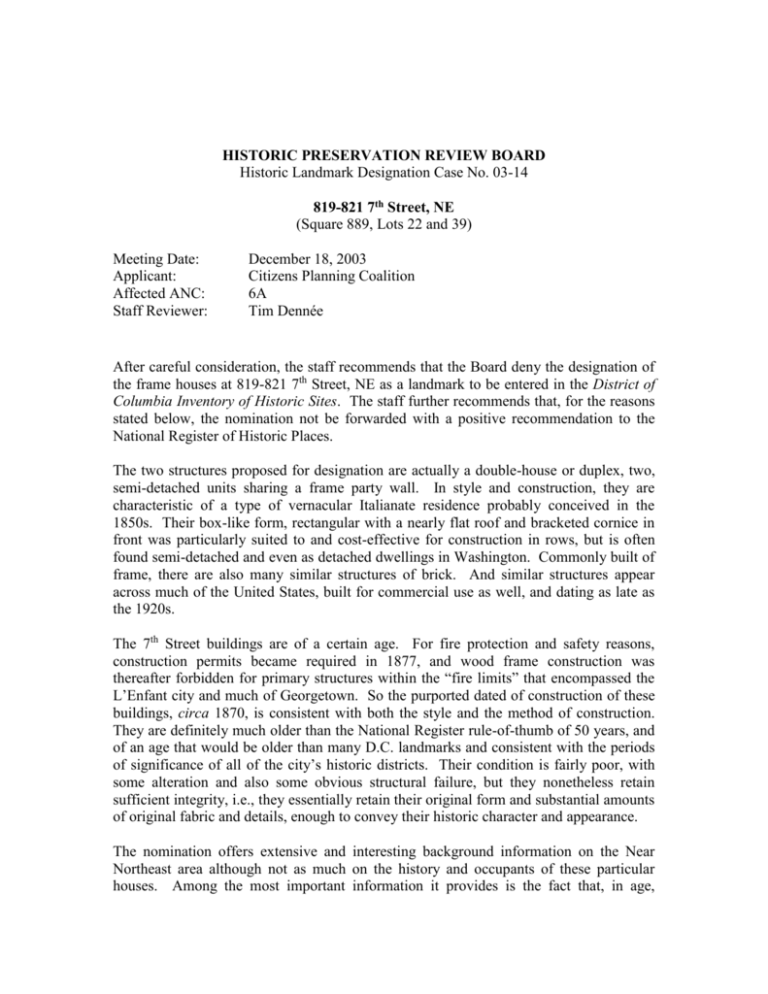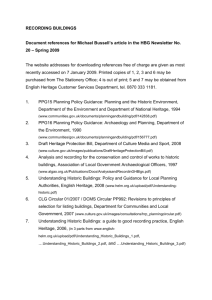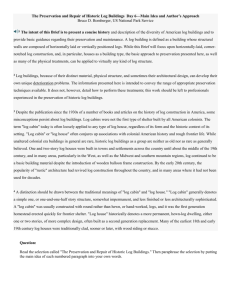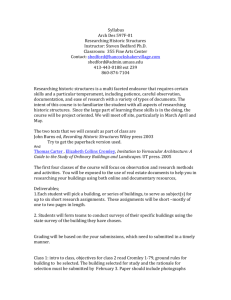historic preservation review board
advertisement

HISTORIC PRESERVATION REVIEW BOARD Historic Landmark Designation Case No. 03-14 819-821 7th Street, NE (Square 889, Lots 22 and 39) Meeting Date: Applicant: Affected ANC: Staff Reviewer: December 18, 2003 Citizens Planning Coalition 6A Tim Dennée After careful consideration, the staff recommends that the Board deny the designation of the frame houses at 819-821 7th Street, NE as a landmark to be entered in the District of Columbia Inventory of Historic Sites. The staff further recommends that, for the reasons stated below, the nomination not be forwarded with a positive recommendation to the National Register of Historic Places. The two structures proposed for designation are actually a double-house or duplex, two, semi-detached units sharing a frame party wall. In style and construction, they are characteristic of a type of vernacular Italianate residence probably conceived in the 1850s. Their box-like form, rectangular with a nearly flat roof and bracketed cornice in front was particularly suited to and cost-effective for construction in rows, but is often found semi-detached and even as detached dwellings in Washington. Commonly built of frame, there are also many similar structures of brick. And similar structures appear across much of the United States, built for commercial use as well, and dating as late as the 1920s. The 7th Street buildings are of a certain age. For fire protection and safety reasons, construction permits became required in 1877, and wood frame construction was thereafter forbidden for primary structures within the “fire limits” that encompassed the L’Enfant city and much of Georgetown. So the purported dated of construction of these buildings, circa 1870, is consistent with both the style and the method of construction. They are definitely much older than the National Register rule-of-thumb of 50 years, and of an age that would be older than many D.C. landmarks and consistent with the periods of significance of all of the city’s historic districts. Their condition is fairly poor, with some alteration and also some obvious structural failure, but they nonetheless retain sufficient integrity, i.e., they essentially retain their original form and substantial amounts of original fabric and details, enough to convey their historic character and appearance. The nomination offers extensive and interesting background information on the Near Northeast area although not as much on the history and occupants of these particular houses. Among the most important information it provides is the fact that, in age, material and form, 819 and 821 7th Street, NE are representative of the types of buildings that were being constructed in the earliest phase of Near Northeast’s urban development. The most significant information is that contained in Section 8, pages 12 and 13 of the nomination, at which the early development pattern of the immediate area is discussed and counts of extant structures are given. Evaluation The District of Columbia’s landmarks criteria imply, by their very existence, a higher standard of significance that that which accorded to or necessary for a structure simply considered to contribute to the character of a historic district. When the criteria refer to “significant events” or persons, to “exemplify[ing]…heritage,” or to “notable works of craftsmen, artists [and design professionals],” they suggest a certain singularity of the resources to which these would apply. Arguably, the broadest criterion is “A-3”—which is closely related to National Register Criterion C—and is most applicable to vernacular buildings and to 819 and 821 7th in particular. Criterion A-3 in the preservations regulations reads, in part, that buildings shall be designated if “[t]hey embody the distinguishing characteristics of architectural styles, building types…[etc.] significant to the appearance and development of the national capital or the nation.” While this criterion might be interpreted to apply to the development of the city as a whole, it is actually applicable to the development of neighborhoods, by extension, as their development individually and in aggregate is necessary for and inextricable from the development of the city. There is no question that 819 and 821 7th Street represent good examples of circa 1870s, modest, frame, Italianate houses. One might even add semi-detached or “twin” houses as well, if such specificity is significant or desirable. But the essential question is, when does a building move from being a representative example of a type to embodying that type or, put another way, when does it go from being a part of a whole set of similar buildings to justifiable standing for that whole? To a large degree, the answer is scarcity. A single example could more accurately said to embody the spirit of all examples when the universe of all examples has shrunk. Scarcity always affects value. Take the most singularly wonderful piece of architecture you can imagine. Now imagine that there were 100 similar examples. Would it still have the same value aesthetically? Or, more to the point here, would any or all of them be landmarks, and how would you choose which? All buildings have qualities that are inherent, whether they are architectural or historical qualities, and it is these qualities that we acknowledge as significant when a building is landmarked. Vernacular buildings are landmarked all the time, but it is perhaps most often the case that such buildings are significant of a type once common enough but that has largely vanished. Then, the value of the greatest monument or the most humble corn crib is greatly affected by its scarcity (and to some extent, near or potential scarcity, in terms of threats). Referring to the actual figures, the nomination states that, in the neighborhood bounded by 2nd Street, F Street, Florida Avenue and Maryland Avenue, NE, there are still about 65 frame houses, not a small proportion of which is of semi-detached houses (fourteen houses or seven pairs). The nomination does make a convincing argument of the increasing scarcity of such residences in the neighborhood, but the matter is relative. First, the argument begs the questions of why these houses—are they the best example(s)? Second, perhaps the extant number is simply not sufficiently small to justify landmarking these because, third, there is actually a large number of extant examples of the box-like Italianate house spread through the city. Again, they appear as rows, semidetached, and freestanding, in original contexts that were predominantly urban, suburban and rural. Several of the historic districts contain numerous examples, including Capitol Hill, Shaw, Anacostia, Georgetown, Mount Vernon Square, Strivers Section and Grant Road, etc. They appear in significant numbers in several other neighborhoods as well, including Brookland, Deanwood, and Barry Farm/Hillsdale. Much of Washington is characterized by rowhouse neighborhoods and by neighborhoods with mixtures of forms but including rowhouse forms. If many rowhouses are to be landmarks on the strength of being representative of types, then why not landmark all rowhouses? In other words—and this is not intended to characterize or caricature the present nomination—if everything is a landmark, then effectively nothing is. If distinctions are to be meaningful, then there must be meaningful distinctions made. Landmarking is intended not just to protect buildings but to extend protection to the most significant, that is, effectively to prioritize significance. There are more efficient ways to afford them protection as a class.1 Typical rowhouse forms in older neighborhoods would lend themselves more to being considered contributing structures in historic districts, although this is admittedly cold comfort to anyone fearing imminent demolition of old structures. Some members of the Board may recall the somewhat related and not geographically distant case of the circa 1860 Timothy Allen House at 316 H Street, NW. The old frame, side-gabled house was threatened by the proposed expansion of a gasoline/service station. Despite its age and scarcity relative to masonry residences in the area, the Board rejected it as a landmark. The Samuel Warner Houses, four frame rowhouses at 1102-1108 10th Street, SE, were nominated and withdrawn in 2001 for similar reasons, in addition to some integrity issues. With regard to National Register eligibility, we could probably make a case for significance on even a local level under Criterion C only if this structure were one of only a handful of such structures in the District, but the commonness of the building type precludes a compelling case. 1 In addition to historic district nominations, other approaches that could protect classes of buildings include multiple-property thematic nominations. The present nomination was submitted as an “emergency” application, and there was simply no time to do the necessary research for a thematic nomination of, say, all pre-1877 frame buildings in the city (and there would have to be a very compelling argument as to why such a nomination could be limited to a particular area of Near Northeast, for instance). We have accepted, and the Board has approved landmark nominations forwarded in accordance with multiple property documentation on D.C. Public schools, but that does not mean that all schools of a certain age will be or should be landmarks. It is doubtful, for instance, that the Board will ever landmark all of the examples of the “extensible school” model designed by the Office of the Municipal Architect in the 1930s.








